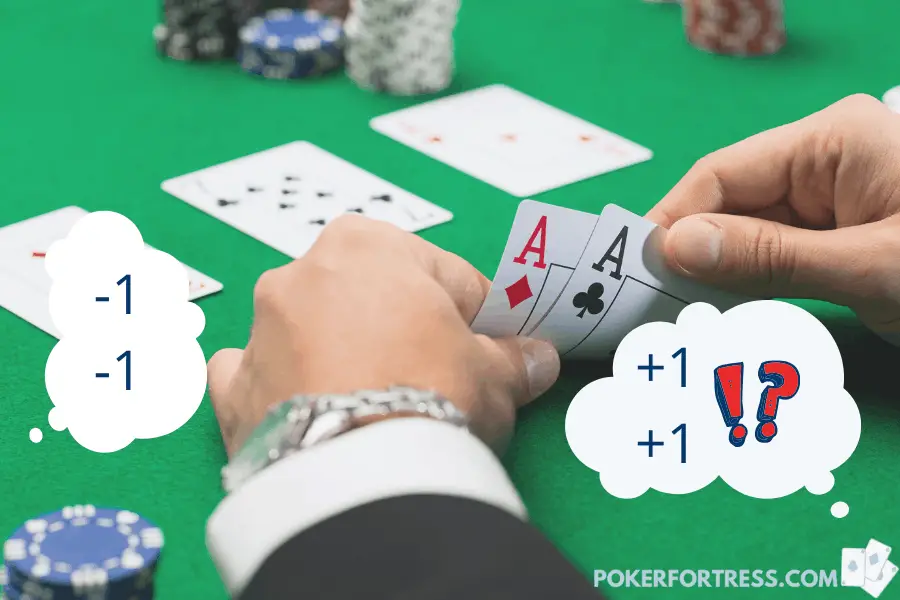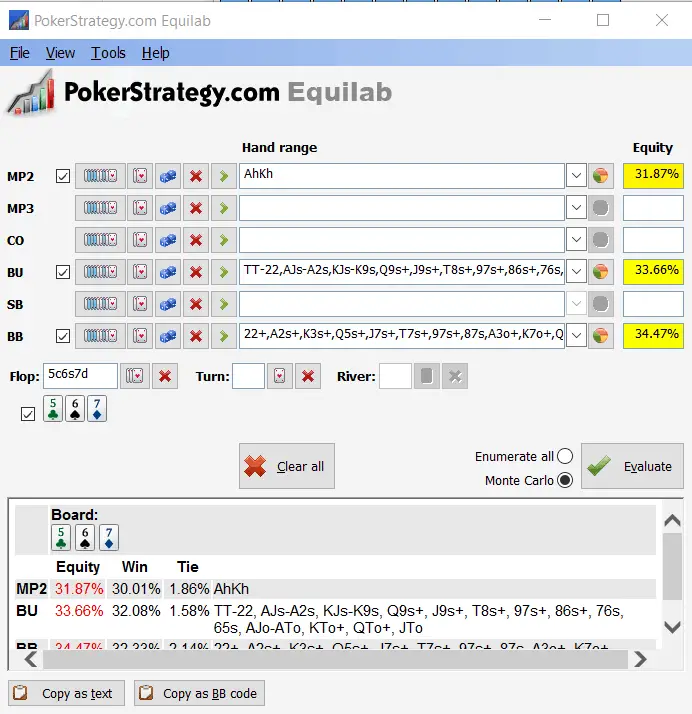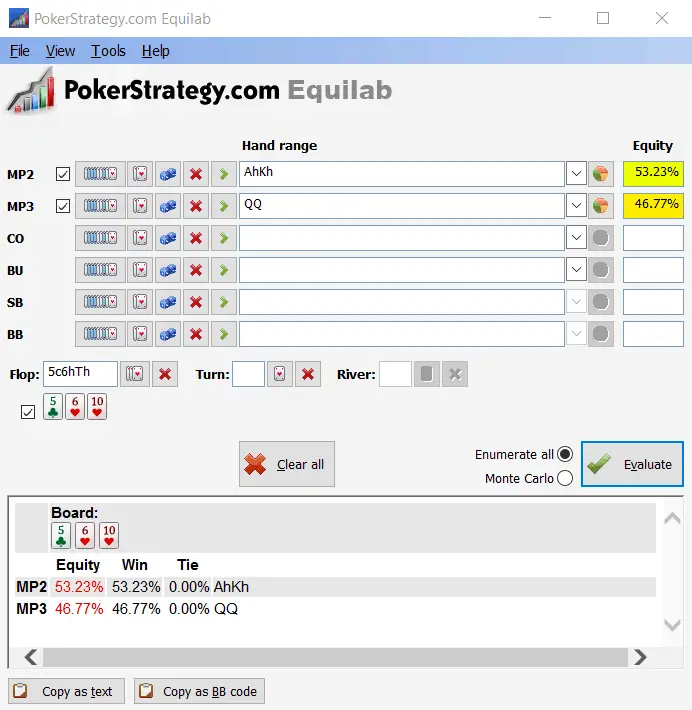Who hasn’t see famous movies where players can count cards, which makes them guaranteed to win longterm. Maybe you are lured into playing poker with thoughts of simply counting cards and making easy money. But can you count cards in poker?

In poker counting cards is not possible. After each hand, a deck gets reshuffled, so this makes it impossible to count the cards. There are some similar moves you can do to succeed in poker and win more games.
Most likely, you already know that in some card games, like blackjack, for example, you can count cards. You add one point for specific cards and subtract one point for others for each card that is revealed. If many good cards are left, before the deck ends, then you are more likely to hit your chicken dinner. This is possible because of new play continuing from where the last one ended in the deck.
However, in poker deck of cards gets reshuffled after each play. This assures that you receive entirely random cards every time. The same goes for the board. No matter what is currently on the board, the next hand will have a completely random combination of cards.
The whole strategy behind counting cards is for one sole reason, making money. Money in poker is made a bit differently, although one of the ways certainly might remind you of counting cards.
Counting cards in poker is possible, but it is done differently than in blackjack. That is why it can’t be really named counting cards. Let me explain this. You want to count the number of outs you have in poker to know if you have the odds with your drawing hand to make the call if the opponent bets. This is called having pot odds and implied pot odds (not having odds to make the call, but counting on winning more chips once you hit the draw) and it is a lot different than counting odds in blackjack.
Sure you technically do count that each out gives you 4% on the flop to river to hit the draw. But this doesn’t give you any advantage over other players since they have the same information as you do.
8 Skills to Master to Make More Money in Poker
1. Know how good is your hand
Know how good your hand is and if you should open it from your current position on the table. This depends mostly on your opponents also. Are they likely to 3-bet you light? Do they play very tight, or like to call a lot pre-flop. Are opponents in blinds very weak and easily beatable?
This are only a few of the questions that every serious poker player will ask himself before playing a hand pre-flop. It is important to have a solid pre-flop and also a postflop plan to maximize profits in poker.
2. How good is your range against opponents range
Knowing how good your hand range does against an opponent’s range of hands. Keep note I said against the opponent’s range and not hand. All seasonal poker players think in terms of hand ranges rather than a single hand.
You cannot merely put an opponent on a specific hand, but you can quite accurately put him on a certain range of hands.
For example, the opponent opens in early position and flop comes JQ2 rainbow. When the opponent starts betting, his range of hands is anything from overcards to top pair, second pair, and overpairs, and some draws, together with some bluffs. It is on you to pay close attention, and then you can know if he, in previous hands, checked with a draw, then maybe he only bets with bluffs and made hands.

The same goes if we open under the gun and get called by button and big blind. If the flop comes 567, we are better to give up. This flop doesn’t hit our pre-flop raise from early position. Our hand range from early position is mostly high cards with pocket pairs.
3. Knowing if your draw is good enough to continue
You need to know how good your draw is on the flop. There is some basic math in poker for draws. Namely, each out that you have to hit from flop by the river gives you around 4% chance to hit. From flop to turn and from turn to river each out is worth around 2%.
With nut flush draw on the flop and overcards, you will often have 9 outs to hit a flush plus 6 more to hit overpair. If all your outs are clean, then you might be a favorite against an overpair.

Often an opponent can be blocking some of your outs, and he is likely to have a better hand than just overpair. That is why poker is straightforward to learn but takes a long time to master.
I have more than 15 000 hours playing poker, and still, I learn something new about the game strategy each day. It is crucial you keep practicing and learning always.
If you don’t want to waste vast amounts of money at the tables for trying what works and what doesn’t, then you some poker coaching website. I started with PokerStrategy after I wasted my first $100. At PokerStrategy, I received free $50 (it’s part of their promotion for every new user), and I got to watch instructional strategy videos for free. Best investment I ever made.
4. Implied odds
Implied odds are another integral part of poker theory. They are a bit harder to determine exactly sometimes.
A quick example of implied odds: Maybe you don’t get direct odds to call with your draw on the flop. But if you were to hit your draw, an opponent would call your bet on the river. And this river bet where you get paid off makes up for you not having direct odds to call the bet on the flop.
But this is a bit tricky if you don’t know yet that the opponent is unable to let his hand go and he calls no matter what. Mastering implied odds come with practice. Poker pros might rely on their HUD stats in such scenarios, when unsure if it makes sense to make the call on the flop.
5. Playing Game Theory Optimal (GTO)
If you are just starting in the poker world, then don’t worry about this yet. GTO becomes more useful when you play against other poker pros on higher stakes. On low limits and micro stakes, just focus on exploiting the mistakes of your opponents, and you will make substantial money.
6. Most similar to counting the cards
Poker comes the closest in terms of simple strategy as is it is to count cards when you are short stacked. This is most common in tournaments and SITNGOs, especially if you play turbo and hyper-turbo formats. You play here depends on ICM calculations.
All you need to learn there to make money is to know push fold ranges. Because stacks are so shallow, often less than 15 big blinds, your only options are to shove or fold pre-flop. There is no post-flop play necessary.
Edges increase the slower the blind structure is, and the deeper the stacks are. You can still make nice money playing hyper turbos, just know it will take many games to determine if you are winning. But the good thing is, you can play them whenever you have little time to spare, and the winning strategy is very basic.
There is special software out there like ICMizer that tell you precisely which hands you should shove with depending on how many blinds you have from each position.
7. Taking notes is another critical skill
You need to make correct notes without useless information and include only the vital part. Color coding players, if you play online, is another “quick note” option that you have at many poker sites.
To take notes, you need to focus on the table and what players are doing. Do not play like a robot and look only at your cards. Observe and make notes, and your winrate will increase.
If you play online, then making notes is easy. You can either do it in the client or hand history software like HoldemManager. Such software is not only useful to save the notes on the opponents, but they do much more.
They tell you where the leaks are in your game. They show you how much money you are making or losing. And the most useful of them is they all come with a HUD display. This tool is essential to every poker pro.
The tool itself is useless if you don’t know how to read the data from it, so mastering this is another essential skill you need to have. It’s all so simple if you play online with so many tools at your disposal.
But how about if you play live poker. Can you make notes in a casino at a live poker table? The short answer is yes. If you want to know how then read the article I wrote about it in detail.
8. Good rakeback deal
For every hand played, a poker site or a casino takes a small amount of the pot for themselves. Having a good rakeback deal is essential. Who doesn’t want to get some of the free money back? Rakeback is only sure income you will receive in poker. You can look at it as a set minimum hourly income you will get for playing. It is free and guaranteed. You only need to make sure you find yourself the best deal possible. If you are still unsure, what is rakeback or where are the best rakeback deals that I use myself, then check this detailed article I wrote.
Conclusion
Now you know why it is impossible to count cards in poker. You also understand what the skills that are required to make money in poker are. With this, you have a nice short blueprint about what is needed for you to be a winning poker player. It is not as simple as counting cards, but it is doable.



